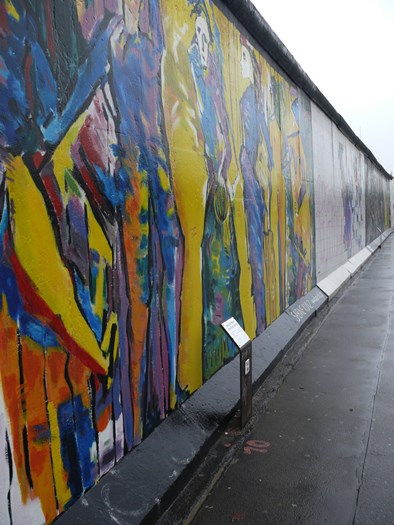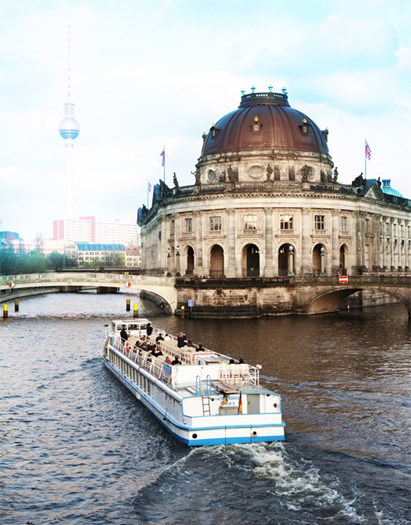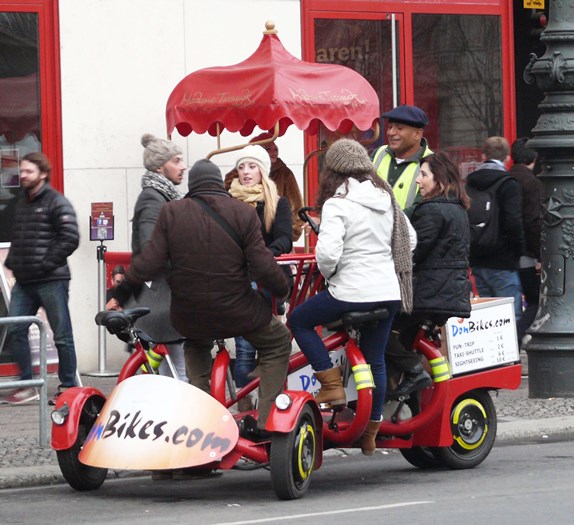BERLIN - “Ich bin ein Berliner!”
I couldn’t wait to stand in front of the Brandenburg Gate and yell out (in German) “I am a Berliner” — just as I remember John F. Kennedy doing in 1963 when I was but a youngster.
But, really, how does a first-time visitor like me prove ich bin ein Berliner?
By drinking lots of beer like Berliners do? Eating plenty of their wonderful sausage? Spending time in great museums as they do on their days off? Hanging out in trendy underground nightclubs until the wee hours of the morning? Sipping strong Turkish coffee in neighbourhoods where weathered buildings supply street artists with a canvas?
I do all that, but still, I’m unsure if the locals are accepting me as one of their own.
“Don’t worry, we accept everybody — that’s the beauty of Berlin. And that’s why people who come to Berlin find it so hard to leave,” says Billie Pittke, a guide who arrived in the German capital from Munich 20 years ago and never left.


Left: Finding reminders of the Berlin Wall won't be easy. Right: A city cruise is delightful.
“Few people living in Berlin were actually born in Berlin,” says Pittke, while showing me the highlights of her adopted city.
What newcomers like most about Berlin, apparently, is that it’s unlike any other German city — its liberal lifestyle, bohemian neighbourhoods, youthful enthusiasm, checkered history and beer bikes set it apart from the “reserved” Germany most people know.
Beer bikes?
“Yes, you can drink and drive in Berlin,” laughs Pittke, while explaining the function of the popular “beer bike” that some people here would like to see run off the roads. “You peddle while drinking beer with a whole group of people — it’s that simple.”
I’m starting to understand why people find Berlin so intoxicating.
Fact is, this once-divided city has attracted more than one million new citizens since the fall of the Berlin Wall in 1989 and one of them is Henrik Tidefjard, a Swede who arrived 11 years ago and set up a lifestyle tour company that now caters to the likes of Madonna.
“Berlin is like no other city in the world — it’s abstract. I fell in love with its free spirit when I arrived and never intend to leave,” says the man Forbes magazine describes as one of the “five most important people to know in Berlin.”
“Here, you are encouraged to be yourself. There’s no pressure. You can walk down a street drinking a beer and no one will say anything. No one judges you. There’s a freedom here and that brings out the best in people,” Tidefjard tells me over a spectacular meal served up by chefs with pierced ears and lips at an underground room called Kater Schmaus in the city’s trendy Kreuzberg district, a place where alternative lifestyles rule.
Both Pittke and Tidefjard agree Berliners are different from all other Germans — while most of the country enjoys a German-produced sparkling wine known as Sekt, Berliners defiantly prefer its Italian rival Prosecco. Most Germans are inward, Berliners are in your face. If Munich likes beer, Berlin likes wine.
“Berliners don’t hide their emotions. Other Germans use the term ‘Berliner schnauzer’ to describe us and loosely translated it means ‘Berliners are big mouths’ and I guess we are,” laughs Tidefjard.
“If you see a Berliner walking down a street at 6 a.m. with a beer in hand, you’re never sure if he’s arriving home or heading out to a club,” says Tidefjard, who led Madonna’s teenage daughter, Lourdes, on a pub crawl when they visited the city.
So, by day, Pittke shows me the tourist sights of Berlin and by night, Tidefjard leads me through the city’s back alleys to some mind-boggling entertainment venues.
Pittke starts my day tour in Pariser Platz, the city’s famous square dominated by the iconic Brandenburg Gate, the symbol of Germany’s reunification in 1989 after the fall of the Berlin Wall.

Above: Falling off this Berlin beer wagon is all part of the fun.
“Berlin actually had 16 entry gates at one time but only Brandenburg remains and the sculpture on top (riding a four-horse chariot) is the Goddess of Triumph and Freedom,” Pittke informs me.
The Brandenburg Gate actually sat out of reach to Western tourists in Communist-controlled East Berlin until the city was reunited, and the thousands who now flock to photograph it each day seem to be making up for lost time.
Pariser Platz is filled with embassies (the U.S. and French are the main occupants), the city’s best hotel — the historic five-star Hotel Adlon Kempinski — and a number of important government and commercial buildings.
In one of them, the guide introduces me to the amazing Frank Gehry “fish” lobby in the DZ Bank building and it ranks among the Canadian architect’s most imaginative designs.
As we walk along the lovely tree-lined Kurfurstendamm, the fashionable boulevard often called Germany’s Champs-Elysées, where most of the capital’s historic buildings are grouped, Pittke points to one massive structure wrapped in scaffolding and identifies it as the National Museum.
“It’s being restored after years of neglect under Communist rule,” she says. “Berlin actually has over 175 museums — more museums than rainy days — but our most impressive museums are just ahead.”
A short time later, after following Pittke through a labyrinth of small streets where old and new architecture fight for my attention, we arrive at a bridge overlooking the River Spree. I’m instantly awestruck by the massive buildings I see standing majestically on an island in the river.
“That’s Museum Island,” says Pittke, who identifies the impressive structures as the Altes (Old) Museum, the Neues (New) Museum, home of a spectacular bust of Egyptian Queen Nefertiti, the Alte Nationalgalerie (National Gallery), Bode Museum and the Pergamon Museum.
The Pergamon Museum is the youngest of the five and the most striking. But what really impresses is what’s housed within — the reconstructed and immense Pergamon Altar and the Ishtar Gate of Babylon. For someone who has visited most of the world’s major museums, the Pergamon quickly jumps onto my Top 5 list.
While exiting the UNESCO World Heritage Museum Island, the guide points to a handsome apartment complex and says “that’s where our Chancellor, Angela Merkel, stays when she’s in Berlin.”
Over the next few days, we visit Berlin’s other tourist treasures:
• The Reichstag, the German Parliament whose glass dome has become one of the must visits of Berlin (just make sure you bring your passport as identification and make an online reservation to gain access), as well as all the buildings that make up the city’s wonderful government quarter.
• Great monuments — the Victory Column that once stood in front of the Reichstag but now stands regally in Grosser Stern (circle), and the massive Soviet war memorial that sits in the shadow of the German Parliament are, along with the Brandenburg Gate, my favourites.
• What remains of the Berlin Wall — a 1.3-kilometre section is all that’s left of the infamous cement dividing line that once stretched 160 kilometres in total. More than 100 global artists were invited to paint images on what remains of the Wall and the intriguing, moving and sometimes funny portraits now form what’s known as the East Side Gallery, the largest outdoor art museum in the world. The Wall is in danger of being torn down — again — thanks to some new builings planned for the area and a war of words on its future is now being waged in Berlin.
• The Castle Charlottenburg, the largest palace in Berlin, which dates back to the 17th century and whose annual Christmas Market is among the best in Europe.
• Daimler City in Potsdamer Platz, where the “New Berlin” continues to take shape — a concrete-and-glass forest that makes this ancient capital look more New York than Old World. Daimler City and nearby Sony World are Berlin’s new entertainment districts and started to take shape after the fall of the Wall. To date, more than 22,000 new buildings have been erected in Berlin since the Wall came down.
• Lots of World War II and Cold War memories — the striking Jewish Memorial that sits just steps from where Hitler’s former bunker (now a parking lot) was located and Checkpoint Charlie impress and I’m glad to see the entrance to Hitler’s old Chancellery is now a Chinese restaurant.
• The massive Tiergarten (Animal Garden), the former imperial hunting grounds that now form one of the most impressive urban parks in Europe. In fact, Berlin holds the title as the “greenest” city on the continent and its citizens take great pride in their eco-awareness.
As entertaining as our day tour of Berlin has been, our enlightened night guide promises to show me a “part of Berlin that few visitors ever get to see or enjoy.”
That’s why we blindly follow him into what looks like a condemned building in the city’s Kreuzberg area, one of Berlin’s poorest districts where immigrant families and young artists share space in dilapidated graffiti-covered buildings.
“Most of the people living in this district aren’t even Germans. Many are Turks and so Kreuzberg is where you’ll get great meals for some ridiculously low prices,” Tidefjard says as he leads me up a narrow staircase past some hard-core beer-drinkers waiting for a first-floor club to open.
“Because this area is much cheaper to live, it attracts a lot of young artists and they leave their marks on the buildings — they’re so talented that shopkeepers even hire them to decorate the walls of their stores.”
Soon we arrive at the top of the former four-storey factory and Tidefjard pushes open a door to reveal the restaurant Kater Schmaus. I’m awestruck. The room is bright and cheerful and packed with people — mostly locals engaged in lively conversation. An army of young servers decorated in tattoos and piercings rush past carrying dishes that look like they’ve been plated by a Michelin-star chef. Off in the corner, some young men are debating the latest political issues.
“These restaurants are called ‘pop-ups’ — and there’s lots in Berlin,” says Tidefjard. “Young chefs open up their kitchens in derelict buildings like this and stay here until the owners decide to tear the building down or renovate. Then the chefs just pick up their kitchens and move to another location.”
The open kitchen, where a posse of chefs are working their culinary magic, is spotless and the meal we’re treated to is every bit as good as what we’ve enjoyed in five-star hotels in downtown Berlin.
The servers are engaging and each has a story to tell.
“I could not get a job when I first came to Berlin so I started working at pop-ups like this,” says Anders from Antwerp. “There’s a freedom at restaurants like this that allows us to be ourselves — no tuxedos here.”
The night soon turns into the wee hours of the morning — good food is followed by great conversation.
We’re all feeling a little bit more like Berliners by the time we leave the restaurant — each of us clutching a bottle of beer as we walk into the dawn and confidentally yelling at the time of our lungs: “Ich bin ein Berliner!”